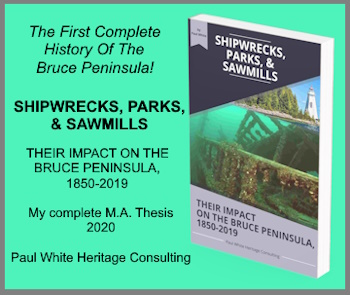Southampton Ontario Suffered a Major Fire
in 1886
Southampton Ontario suffered a major fire in 1886: The havoc was created by a furious high wind storm that spread the flames over much of the town.
The threat of fire was one of the worst fears of the early citizens of this region. I have already detailed the horrific fires that struck Owen Sound. But even fiery holocausts such as the one that demolished the North American Bent Chair factory in the late 1890s pales in comparison to the inferno that swept through Southampton in 1886.
Early in the morning of Nov. 4, 1886, a resident tending a sick child noticed smoke coming from the basement of the Rossin Block. Neighbours tried to put out the fire but when a basement window was broken, the northwest high winds soon whipped the flames into an inferno.
One of the neighbours ran to sound the fire bell. The fire brigade and other volunteers thought they would be able to contain the blaze to the Rossin Block. Unfortunately, when the roof caved in the roaring wind-swept burning embers across Grosvenor Street to the Busby Hotel. It was not long before that building was on fire.
The wind was not a friend to the beleaguered firefighters. It was not long before other buildings were in flames. Soon the fire had spread along the north side of High Street. Roadways did not impede this 'inferno. At Albert Street the flames "jumped the road and spread just as rapidly through the next block."
At 8 a.m., just four hours after the fire had first been detected, "not a single store, dwelling or other structure was left for two blocks along the north side of High Street".
Dr. J. F. Morton, writing seven decades later in The Sun Times, reported that residents living further away from the scene of the fire had wrapped their homes in wet blankets "or any other large cloth that would hold water" to protect them from destruction.
More than 50 buildings were destroyed that cold November morning with an estimated loss totaling $60,000. Insurance only covered $12,000 of that.
There was an immediate appeal for financial assistance for the victims. The first money to arrive was on board the train headed for Southampton. The train's conductor, a Mr. Lillies, collected "a substantial sum from the travelers on the train."
One of the first responses to this call came from the nearby Saugeen First Nation. Virtually every municipality in the area responded with some form of assistance. Many other communities throughout Ontario also sent donations to assist Southampton residents. This generosity is not surprising given the fact that in the late 1800s fires were the worst nightmare of communities and their residents. Most buildings were mainly built of wood and firefighting was left to volunteers and neighbours. Consequently, the events of the early morning of Nov. 4, 1886, simply put an exclamation mark on fears of everyone at that time.
The information used in this article came from early editions of area newspapers and especially from an article written by Dr. J.F. Morton in a 1958 edition of The Sun Times.
A version of this story first appeared in my Local History column in the Owen Sound Sun Times on March 1, 2002.
Bruce County History
Bruce County history is rich with stories about the development of communities along the Lake Huron shoreline and shaped by memorable events and the people.
The "Battleship By-Election" was the result of a debate that embroiled all of Canada but was settled in a rural region of southwestern Ontario prior to the First World War.
Bruce Road 3: A Colonization Road linked prospective settlers to undeveloped Crown Lands and a new life.
British Peerage a Source for Township Names. It is interesting to check the origin of the names bestowed on pioneer places such as towns, townships and counties.
Chesley Ontario Welcomes the Krug Brothers who were looking for a place to make their future and their fortune. They were not only successful, but they made significant contributions to the social fabric of their adopted home town.
Billy Crawford: Pioneering Spirit Personified. If you take the time to consider the people you have met during your life you too may know or have known, someone with pioneering spirit just like Billy Crawford.
Frozen Rivers & Lakes can be Hazardous: Icy waterways offer many benefits such as ice fishing, but beware weak, or thin ice is not easily detected and can spell disaster.
Kincardine Ontario's First Settlers using a bit of savvy and some luck created a future for themselves and their families on the Lake Huron shoreline.
The Krug Impact on Chesley Ontario was immense not only in terms of the community's social fabric but with regards to community's economic growth.
Wilfrid Laurier: Despite the town's best efforts to make Wilfrid Laurier's visit a memorable occasion, it would be clouds of dust that would remind the Prime Minister of the Lake Huron community.
Mildmay Ontario overcame competition from other communities to claim its spot in Carrick Township on an important settlement route to the Lake Huron shoreline.
Pioneer Diaries provide Interesting Information about many topics, but sometimes information about the weather can be quite surprising!
The pioneer settlement in Arran Township was completed in 1851. The survey crew had been impressed, by the cheap cost and the potential of the land, that two members of the team, George Gould and Richard Berford, took up plots of land.
Port Elgin Ontario Started with a Storm. A ship forced to seek refuge from Lake Huron's stormy wrath signalled to one man the idea of starting a new community.
Southampton's early history was a time of identity crisis, and with a connection to an early Arctic mystery story.
Southampton Ontario Suffered a Major Fire in 1886: The havoc was created by a furious high wind storm that spread the flames over much of the town.
Tara Ontario's Mill Started the Village Economy and with the entrepreneurial and inventive genius of one man the community prospered!
Walkerton Ontario: The Beginning of this Bruce County town is the result of the drive and determination of one man, Joseph Walker.





